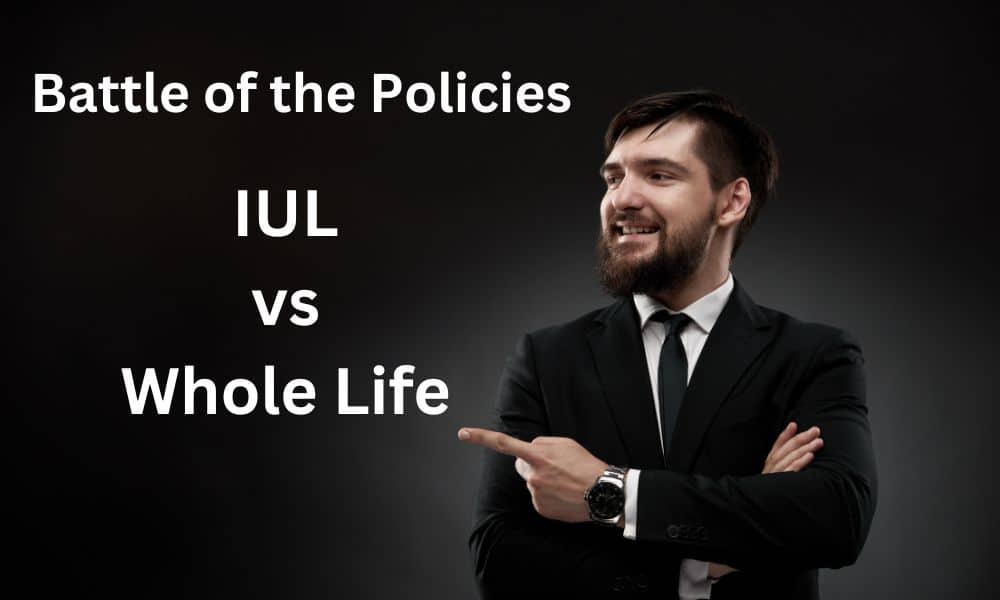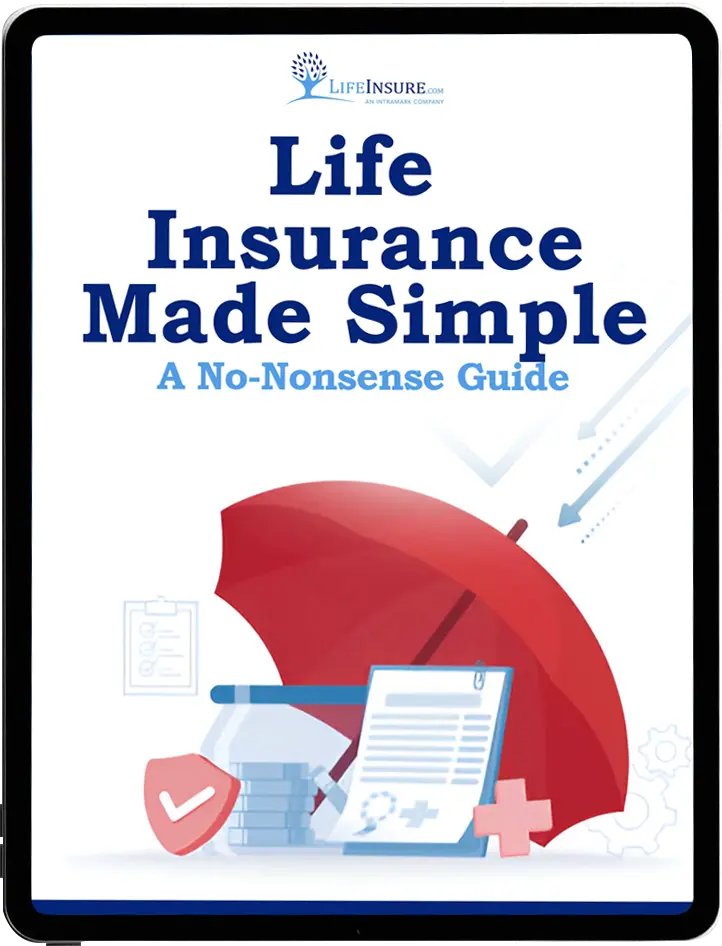
Battle of the Policies: Indexed Universal Life (IUL)Vs. Whole Life Insurance
In the ever-evolving world of financial planning, the battle between Indexed Universal Life (IUL) insurance and whole-life insurance rages on. These two types of permanent life insurance policies offer distinct approaches to safeguarding the financial futures of loved ones.
While IUL policies intertwine a death benefit with potential cash value growth, whole life insurance guarantees both a death benefit and accumulates cash value over time.
This article will provide an analytical breakdown of these policies, including their features, costs, and customization options, empowering readers to make informed decisions about their life insurance needs.
Definition and Purpose for IUL vs Whole Life
Indexed Universal Life insurance (IUL) and whole-life insurance are distinct types of cash-value life insurance policies that serve the purpose of providing financial protection to beneficiaries upon the insured’s death.
An IUL policy is a type of universal life insurance policy that offers a death benefit and a cash value component that can grow based on the performance of an index, such as the S&P 500. On the other hand, whole-life insurance policies provide a guaranteed death benefit and a cash value that grows over time.
Indexed Universal Life Insurance policies typically have flexible premiums, allowing policyholders to adjust their contributions, while whole-life insurance policies usually have fixed premiums.
The cash value of IUL policies can grow based on the performance of an underlying index, while whole life insurance policies provide guaranteed cash value growth.
IUL policies offer flexibility in terms of premium payments, death benefit options, and cash value growth, while whole life insurance policies provide less flexibility.
Both types of policies can be customized to meet specific financial goals and objectives.
Premiums and Costs
In the battle of the policies, the discussion now shifts to the subtopic of premiums and costs in comparing IUL and whole-life insurance. Here are some key points to consider:
- IUL policies typically offer premium flexibility, allowing policyholders to adjust their contributions. On the other hand, whole-life insurance policies usually have fixed premiums that remain the same throughout the policy’s duration.
- When comparing costs, IUL policies may have lower initial premiums than whole-life insurance. However, whole-life insurance premiums tend to be higher due to the guaranteed death benefit and cash value accumulation.
- The cost of both policies depends on factors such as age, health, and coverage amount. It is important to evaluate the long-term affordability of premiums and potential returns when comparing costs.
Comparing Cash Value Growth of IUL vs Whole LIfe
Continuing the comparison between IUL and whole-life insurance, let’s delve into the subtopic of cash value growth. The cash value of an IUL policy can grow based on the performance of an underlying index, such as the S&P 500. IUL policies often have a cap or participation rate that limits the amount of growth credited to the cash value.
On the other hand, whole-life insurance policies provide guaranteed cash value growth, which accumulates over time. The cash value of whole-life insurance can be accessed through policy loans or withdrawals. While IUL policies may offer more potential for cash value growth, they also carry higher market risks.
The table below summarizes the key aspects of cash value growth for both IUL and whole-life insurance:
| Aspect | Indexed Universal Life (IUL) | Whole Life Insurance |
|---|---|---|
| Potential Market Risks | High | Low |
| Access to Cash Value | Policy Loans, Withdrawals | Policy Loans, Withdrawals |
Death Benefit
Moving forward in the comparison between IUL and whole-life insurance, let’s explore the aspect of the death benefit. Here are some key points to consider:
- Increasing the death benefit: With an IUL policy, policyholders may have the option to increase or decrease the death benefit during the policy term. This allows for flexibility in adjusting the coverage amount based on changing needs.
- Types of death benefit riders: Both IUL and whole-life insurance policies offer various riders that can enhance the death benefit. Examples include the accelerated death benefit rider, which allows for the early payout of a portion of the death benefit if the insured is diagnosed with a terminal illness, and the accidental death benefit rider, which provides an additional death benefit if the insured dies as a result of an accident.
- Guaranteed death benefit: Whole-life insurance policies provide a guaranteed death benefit that remains in force as long as premiums are paid. This can provide peace of mind, knowing that beneficiaries will receive a certain amount upon the insured’s death.
- Higher death benefit: Generally, whole-life insurance policies offer a higher death benefit than IUL policies. This can be advantageous for individuals looking to maximize the financial protection for their loved ones.
- Tax-free death benefit: Both IUL and whole-life insurance policies can provide a tax-free death benefit to beneficiaries. This means the payout is not subject to income tax, allowing beneficiaries to receive the full benefit.
Flexibility and Customization
Let’s delve into the aspect of flexibility and customization when comparing IUL and whole-life insurance policies. Both types of policies offer policy options and policy adjustments to meet the specific needs and preferences of the policyholders.
IUL policies provide flexibility in terms of premium payments, allowing policyholders to adjust their contributions based on their financial situation. They also offer options to increase or decrease the death benefit during the policy term, providing the ability to customize the coverage amount. Additionally, the cash value growth of an IUL policy can be influenced by the performance of an underlying index, providing the potential for higher returns.
On the other hand, whole-life insurance policies provide less flexibility compared to IUL policies. Premiums are usually fixed throughout the policy’s duration, and the death benefit remains guaranteed as long as premiums are paid. While whole life insurance is considered a more traditional option, it can still be customized to meet specific financial goals and objectives.
Overfunding an Indexed Universal Life Insurance Policy
Overfunding an Indexed Universal Life (IUL) policy involves paying more into the policy than what is required to cover the cost of insurance and administrative fees. This strategy is often used to maximize the cash value growth within the policy and can offer several potential benefits. Here’s how it works:
- Premium Flexibility: IUL policies typically have a minimum premium requirement to keep the policy in force, covering the cost of insurance and administrative charges. Overfunding occurs when you contribute more than this minimum required premium. The excess amount is allocated to the cash value component of the policy.
- Cash Value Growth: The overfunded portion of the premium goes into the cash value account, which has the potential to grow over time. The cash value in an IUL policy is often tied to the performance of an underlying index, such as the S&P 500. When the index performs well, the cash value can increase at a higher rate. However, it’s important to note that some policies may have caps or participation rates that limit the amount of growth credited.
- Tax Advantages: Overfunding an IUL policy can provide tax advantages. The cash value in an IUL policy grows tax-deferred, meaning you do not pay income tax on the gains as long as the money remains within the policy. This can help your cash value accumulate more rapidly than taxable investment options.
- Access to Cash Value: Policyholders can access the cash value through policy loans or partial withdrawals. These withdrawals are typically income-tax-free up to the amount of premiums paid into the policy (considered the “basis”). Any gains beyond the basis may be subject to income tax if not handled correctly.
- Enhanced Retirement Income: Overfunding can be a strategy to build up cash value over time, which can be used to supplement retirement income. Some policyholders use the cash value as a source of tax-free income during retirement.
- Policy Flexibility: Overfunding provides flexibility within the policy. Policyholders can adjust the premium amounts as long as they meet the minimum required premium to keep the policy in force. This flexibility can be advantageous if your financial situation changes over time.
It’s essential to work closely with a financial advisor or insurance professional when considering overfunding an IUL policy. Overfunding should align with your long-term financial goals and risk tolerance, and you should have a clear understanding of the policy’s features, fees, and potential risks. Additionally, tax implications can vary depending on how you access the cash value, so consulting a tax advisor is also advisable to ensure you optimize the tax benefits of your IUL policy.
How Does the Performance of the Underlying Index Affect the Cash Value Growth in an IUL Policy?
The performance of the underlying index plays a pivotal role in shaping the cash value growth within an Indexed Universal Life (IUL) policy. When the selected index performs well, the cash value within the policy has the potential to experience substantial growth. This growth is typically tied to the positive movements of the chosen index, and some IUL policies may offer a feature known as a participation rate, which determines how much of the index’s gains are credited to the cash value.
For example, if the underlying index sees a 10% increase in a given year and the policy has a participation rate of 80%, the cash value will grow by 8%. However, it’s important to note that there is typically a cap on the maximum amount of growth that can be credited in a specific period. This cap is designed to mitigate excessive risk exposure for the insurance company and can vary from one policy to another.
Can Policyholders of Whole-Life Insurance Policies Adjust Their Premiums?
Unlike some other types of insurance policies, policyholders of whole-life insurance policies typically do not have the flexibility to adjust their premiums. Whole-life insurance policies are characterized by fixed premiums, meaning the premium amount remains constant for the entire policy duration.
This fixed premium structure provides a level of financial predictability for policyholders, allowing them to plan their long-term financial commitments with confidence. While this stability is beneficial for many individuals, it also means that policyholders cannot decrease or increase their premiums according to their changing financial circumstances, unlike some other forms of insurance like term life insurance, where premium adjustments are possible at renewal.
Are There Any Limitations on Accessing the Cash Value of a Whole-Life Insurance Policy?
Yes, there can be limitations on accessing the cash value of a whole life insurance policy. The policy’s terms and conditions typically define these limitations. Some common restrictions on cash value access include:
- Surrender Charges: Many whole-life policies impose surrender charges if you choose to cash in or surrender your policy during its early years. These charges decrease over time and may eventually disappear, typically after a certain number of years.
- Loans: Policyholders may be allowed to take out loans against the cash value of the policy, but these loans accrue interest, and unpaid loans can reduce the death benefit. Additionally, outstanding loans can lead to tax consequences if the policy lapses.
- Partial Withdrawals: Some policies permit partial withdrawals of the cash value, but these withdrawals may also have tax implications and can reduce the death benefit.
- Surrender Charges: Many whole-life policies impose surrender charges if you choose to cash in or surrender your policy during its early years. These charges decrease over time and may eventually disappear, typically after a certain number of years.
- Loans: Policyholders may be allowed to take out loans against the cash value of the policy, but these loans accrue interest, and unpaid loans can reduce the death benefit. Additionally, outstanding loans can lead to tax consequences if the policy lapses.
- Partial Withdrawals: Some policies permit partial withdrawals of the cash value, but these withdrawals may also have tax implications and can reduce the death benefit.
- Policy Provisions: The specific policy contract may have additional provisions or restrictions on accessing the cash value, so it’s essential for policyholders to review their policy documents to understand the limitations and options available.
What Factors Determine the Amount of the Death Benefit in an IUL Policy?
The amount of the death benefit in an Indexed Universal Life (IUL) policy is influenced by several factors, including:
- Chosen Coverage Amount: The policyholder selects the initial death benefit amount when purchasing the policy. This is the base amount that will be paid to beneficiaries upon the insured’s death.
- Performance of the Underlying Index: The death benefit in an IUL policy can be tied to the performance of the underlying index. If the index performs well, the death benefit may increase over time.
- Premium Payments: The amount and frequency of premium payments made by the policyholder impact the cash value, which in turn can influence the death benefit.
- Policy Provisions: Some IUL policies offer options to increase or decrease the death benefit during the policy term. Policyholders can exercise these options to adapt the coverage to their changing needs.
- Costs and Fees: Policy costs and fees, including insurance charges and administrative expenses, can affect the growth of the cash value and, consequently, the death benefit.
How Do IUL and Whole-Life Insurance Policies Differ in Terms of Tax Implications for Beneficiaries?
Indexed Universal Life (IUL) and whole-life insurance policies diverge in terms of tax implications for beneficiaries:
- Tax-Free Death Benefit: Both IUL and whole-life insurance policies generally provide a tax-free death benefit to beneficiaries. This means that the proceeds paid out to beneficiaries upon the insured’s death are typically not subject to federal income tax.
- Cash Value Growth Taxation: Here’s where the key difference lies. In an IUL policy, the cash value growth is often linked to the performance of the underlying index. When policyholders access this cash value, any gains may be subject to income tax. However, beneficiaries typically receive the death benefit tax-free.
- Whole-Life Policies: In contrast, whole-life insurance policies build cash value over time, and policyholders can access this cash value through loans or withdrawals. These withdrawals are typically not subject to income tax, as they are considered a return of basis (the portion of premiums paid that exceeds the cost of insurance). However, if the policy lapses, any remaining cash value may be subject to income tax.
In summary, while both IUL and whole-life policies offer a tax-free death benefit, the taxation of cash value growth differs, with IUL potentially having additional tax implications for beneficiaries when accessing the cash value. It’s essential to consult a tax professional for personalized guidance on your specific insurance and tax situation.
Conclusion
In conclusion, the debate between Indexed Universal Life (IUL) insurance and Whole Life insurance is one that hinges on the policyholder’s financial goals, risk tolerance, and long-term planning strategies. IUL offers flexibility and the potential for higher returns linked to a stock index, which can be enticing for those looking to potentially grow their cash value aggressively. However, this comes with a level of risk and complexity that may not be suitable for every investor. It’s essential for individuals to understand the nuances of how the policy credits interest and the potential impact of cap rates and participation rates on their returns.
On the other hand, Whole Life insurance provides a more conservative investment approach with guaranteed cash value growth and predictable premiums. This can be a solid foundation for those seeking stability and certainty in their financial planning. The dividends paid can also enhance the policy’s value over time, though they are not guaranteed. Ultimately, the choice between IUL and Whole Life insurance should be informed by an in-depth conversation with a financial advisor, who can help assess personal financial situations and future objectives. The decision is not just about the potential returns or costs but about how the policy fits into a broader financial plan and the peace of mind it can offer.
For more information about the differences between IUL and Whole Life Insurance, contact the insurance professionals at LifeInsure.com at 866-868-0099 or contact us through our website.
Frequently Asked Questions
Indexed Universal Life Insurance is a type of permanent life insurance policy that provides both a death benefit and a cash value component. The cash value in IUL is tied to a stock market index, like the S&P 500, allowing the potential for higher returns compared to traditional whole life insurance. However, it also comes with certain risks and caps on returns.
Whole Life Insurance is a form of permanent life insurance that offers a guaranteed death benefit, fixed premiums, and a cash value component. The cash value grows at a guaranteed, fixed rate set by the insurance company. Whole Life Insurance is known for its stability and predictability, making it a popular choice for long-term financial planning.
The main differences lie in their investment components and premiums. IUL offers potentially higher returns linked to market indexes but with more risk, while Whole Life provides steady, guaranteed growth. Whole Life premiums are typically higher and fixed, whereas IUL premiums are more flexible but can increase over time.
IUL policies are best suited for individuals looking for life insurance with a potential for higher returns and who are comfortable with some level of market risk. It’s ideal for those who want flexibility in premium payments and who have a long-term investment horizon.
Whole Life Insurance is generally recommended for people seeking a stable and guaranteed growth of cash value, along with consistent premium payments. It is particularly beneficial for those with long-term financial goals, like estate planning or providing a legacy.
Get Permanent Life Insurance Quotes Now!
Last Updated on November 26, 2024 by Richard Reich


